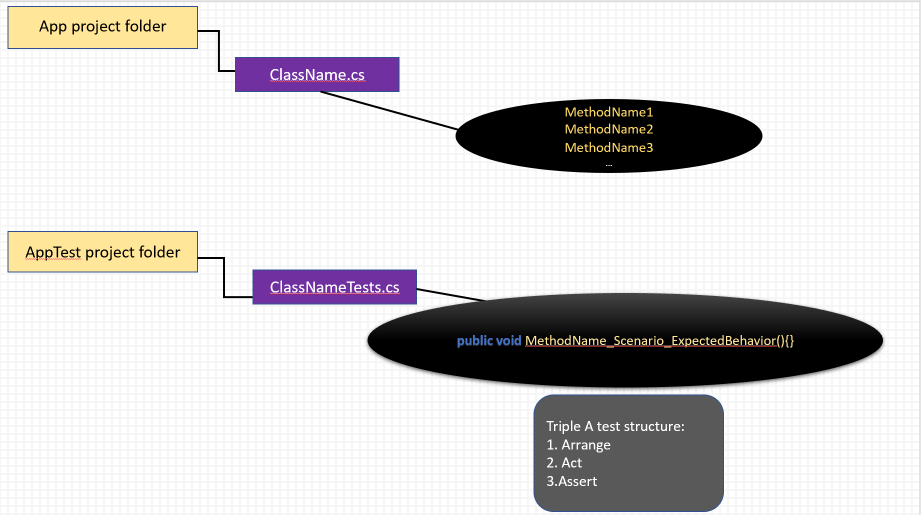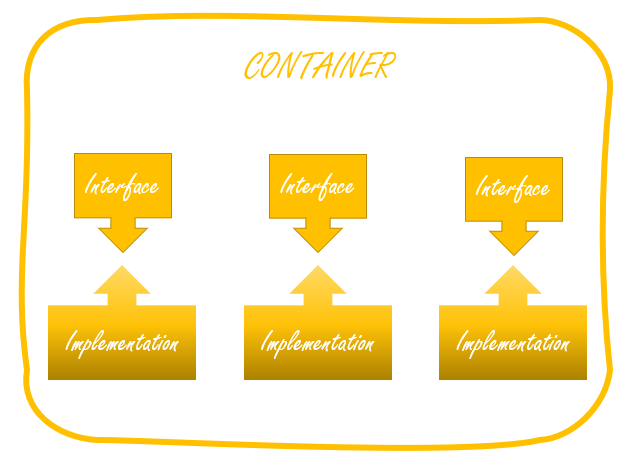This document was create initally as notes to Mosh Hamedani's Udemi Course. A more detailed explanation and the whole project can be found in its course, from which these examples are taken.
For convinience here I will follow the structure of project used by Mosh in its course that can be symplified in the following picture.

- If in the app the class is called
ClassName.cs, in the unit testing folder we will have a file named after itClassNameTests.cs. - The project folder will follow the same rule eg,
AppName=>AppName.UnitTest. - The tests are always
public voidmethods and are named as follows :MethodName_Scenario_ExpectedBehavior.- Note: A void function is a command function because it perfomrs an action. It's aimed to check that the state of an object in memory changes, it may also mean that the value of one or more property change.
- The test body follows the Triple 'A' structure:
- Arrange: is where we initalize the object
- Act: is the action/method we are going to test
- Assert: is the test and the expected behaviour
- NUnit Framework uses the following decorations:
[TestFixture]=> applied to the Class itself[SetUp]=> applied to the SetUp method before the tests methods[Test]=> applies to the method we are testing, it's the test itself.
optional[TestCase]=> a cleaner way to write tests with different results is making it generic. This technique is called Parameterize.[Ignore("testing usage of Ignore decoration")]=> to tell the machine to ingore the test, this is used instead of cancel or comment out a test, so to not ferget.(the test will be output as skipped).
This document will walk you through some practical examples on different types of dependecy injection, how to inject them and the way these can be unit tested.
There are three ways to implement dependency injections:
- via method parameter
- via constructors
- via properties
Sometimes the choice of which type of inejction to use can be technical: for example some frameworks do or do not accept injection via property. Or if the signature of a method using a parameter injection changes, the code breaks unless it will be modified in the rest of the code. Other times it depends on the architecture of the app or the team prerefences, in this case our flexibility is the clue. Let's see these in detail.
The first approach is using a method parameter:
in VideoService.cs file (app file)
public string ReadVideoTitle(IFileReader fileReader)
{
var str = fileReader.Read("video.txt");
//do something
}
in program.cs file we have passed an instance of a class that implement the FileReader.
But in real life we don't initialize new fileReader, we inject the framework instead.
public class Program
{
public static void Main()
{
var service = new VideoService();
var title = service.ReadVideoTitle(new FileReader());
}
}
in the unitTest projectwe recreate the same structure as the app project for consistency.
In Mosh project we have a folder called "Mocking" so we create a class videoServiceTests.cs in it.
Here we will implement a mock function as follows:
[TestFixture]
public class VideoServicesTests
{
[Test]
public void ReadVideoTitle_EmptyFile_ReturnsErrorMsg()
{
var service = new VideoService();
var result = service.ReadVideoTitle(new FakeFileReader());
Assert.That(result, Does.Contain("Error").IgnoreCase);
}
}
N.B. This method has some challenges, for example if its signature changes, the modifications need to be done in all other places it's been used. Also some injection framework can not inject methods via parameters. So this approach requires to take into counts:
- If it's allowed by the framework used in the app.
- How many times the method you're using is present in your app.
The second approach is via property and is inintialized with a constructor :
in VideoService.cs file
public IFileReader FileReader { get; set; }
public VideoService()
{
FileReader = new FileReader();
}
in the program file we need to remove the parameter(from the previous example)
public class Program
{
public static void Main()
{
var service = new VideoService();
var title = service.ReadVideoTitle();
}
}
as well as in VideoServiceTests file and we need to initialize the file reader property with a "fake" property
in our case we created a class in our UnitTests project called FakeFileReader (by name convention can be named Stub or Fake or Mock + interface name), as follows:
public class FakeFileReader : IFileReader
{
public string Read(string path)
{
return " ";
}
}
[TestFixture]
public class VideoServicesTests
{
[Test]
public void ReadVideoTitle_EmptyFile_ReturnsErrorMsg()
{
var service = new VideoService();
service.FileReader = new FakeFileReader();
var result = service.ReadVideoTitle();
Assert.That(result, Does.Contain("Error").IgnoreCase);
}
}
N.B. some Framework doesn't accept injections via properties.
Another alternaive to the first two methods is the injection of a dependecy via a constuctor parameter, as follows:
in videoService file
public class VideoService
{
private IFileReader _fileReader;
public VideoService(IFileReader filetreader)
{
_fileReader = filetreader;
}
}
Note, that this field needs to be private and by convention the naming will start with the underscore character. If we are modify an existing code this latter implementation might break the code in other spots. A better alernative is to create a default constructor that doesn't take a parameter, like this:
public class VideoService
{
private IFileReader _fileReader;
public VideoService()
{
_fileReader = new FileReader();
}
public VideoService(IFileReader filetreader)
{
_fileReader = filetreader;
}
}
A further improvement to this code can be to combine into one these two steps:
- set the parameter as null by default
- set the
_filereaderprivate field using a ternary conditional operator (more precisely a null-coalescing operator).
public class VideoService
{
private IFileReader _fileReader;
public VideoService(IFileReader filetreader = null)
{
_fileReader = filetreader ?? new FileReader();
}
}
Setting the parameter as null by default will make the method work where no parameter are passed.
Using the ternary conditional operator will set the _filereader private field
as the parameter received
or
if null, it will be initialized.
We also need to change the VideoServiceTest file like this:
[TestFixture]
public class VideoServicesTests
{
[Test]
public void ReadVideoTitle_EmptyFile_ReturnsErrorMsg()
{
var service = new VideoService(new FakeFileReader ());
var result = service.ReadVideoTitle();
Assert.That(result, Does.Contain("Error").IgnoreCase);
}
}
N.B. using the null-coalescing operator can be a solution but is not used in the real world, because this class might have more dependencies. In that case this expression will be repeated over and over. But above of all in real world the null parameter is not a good practice. This latter approach is defined as "poorman's dependency injection". In real life application, the best solution will be to use a framework injection.
A dependency injection framework will take care of creating and initializing object at run time. There are various framework you can choose from: NInject, StructureMap, Spring.NET, Autofac, Unity. They all based on the same principles: A container which is a registry of all interfaces and implementations.
When the application starts, it will take care of creating object graphs based on the interfaces and types registered in the container. Using the same principle with Mocking Isolation Framework, we can create dynamically mock objects as part of the tests' suit, and more important we can program them to behave the way we want. Eg. returning a value, throw an exception, raise an events. Here too we have options like: Moq, NSubstitute, FakeItEasy, Rhino Mocks.
The framework (in our case Moq) will replace and implement the FakeFileReader.cs file.
In the VideoTestService.cs we need to initialize the mock object using the generic argument like so:
var mockfileReader = new Mock<IFileReader>(); as this is a framework the mock object we are initializing hasn't a behaviour, so we need to program it like our app object.
VideoService.cs
public class VideoService
{
private IFileReader _fileReader;
public VideoService(IFileReader filetreader)
{
_fileReader = filetreader;
}
public string ReadVideoTitle()
{
var str = _fileReader.Read("video.txt");
var video = JsonConvert.DeserializeObject<Video>(str);
if (video == null)
return "Error parsing the video.";
return video.Title;
}
}
the ReadVideoTitle() is calling the .Read() receiving a string "video.txt" and it returns a string.
To do so we need to use the built-in setup() method, like this:
fileReader.Setup(fr => fr.Read("video.txt")).Returns("");
N.B. Mocks should be reserved only for external dependencies
it should look like this:
[TestFixture]
public class VideoServicesTests
{
[Test]
public void ReadVideoTitle_EmptyFile_ReturnsErrorMsg()
{
var fileReader = new Mock<IFileReader>();
fileReader.Setup(fr => fr.Read("video.txt")).Returns("");
var service = new VideoService(fileReader.Object);
var result = service.ReadVideoTitle();
Assert.That(result, Does.Contain("Error").IgnoreCase);
}
}
Certainly if we need to use the framework for more than one test we might want to create a setup function.
[TestFixture]
public class VideoServicesTests
{
private VideoService _videoService;
private Mock<IFileReader> _fileReader;
[SetUp]
public void SetUp()
{
_fileReader = new Mock<IFileReader>();
_videoService = new VideoService(_fileReader.Object);
}
[Test]
public void ReadVideoTitle_EmptyFile_ReturnsErrorMsg()
{
_fileReader.Setup(fr => fr.Read("video.txt")).Returns("");
var result = _videoService.ReadVideoTitle();
Assert.That(result, Does.Contain("Error").IgnoreCase);
}
}
read more about Triple A structure
- Moq
- NUnit
- NUnitTestAdapter
